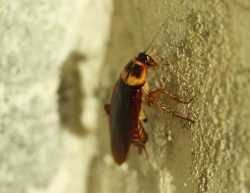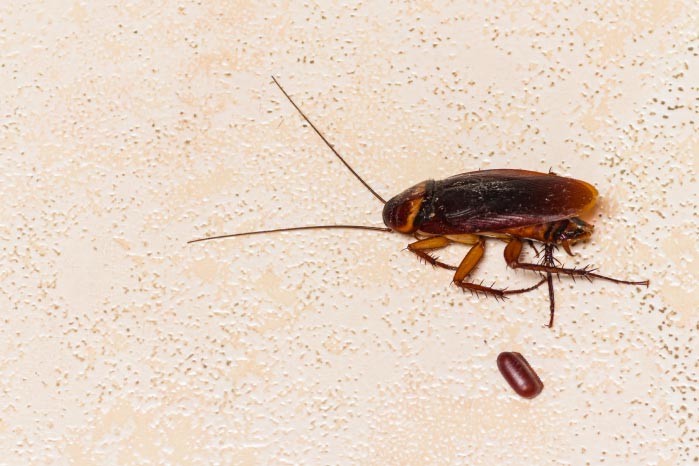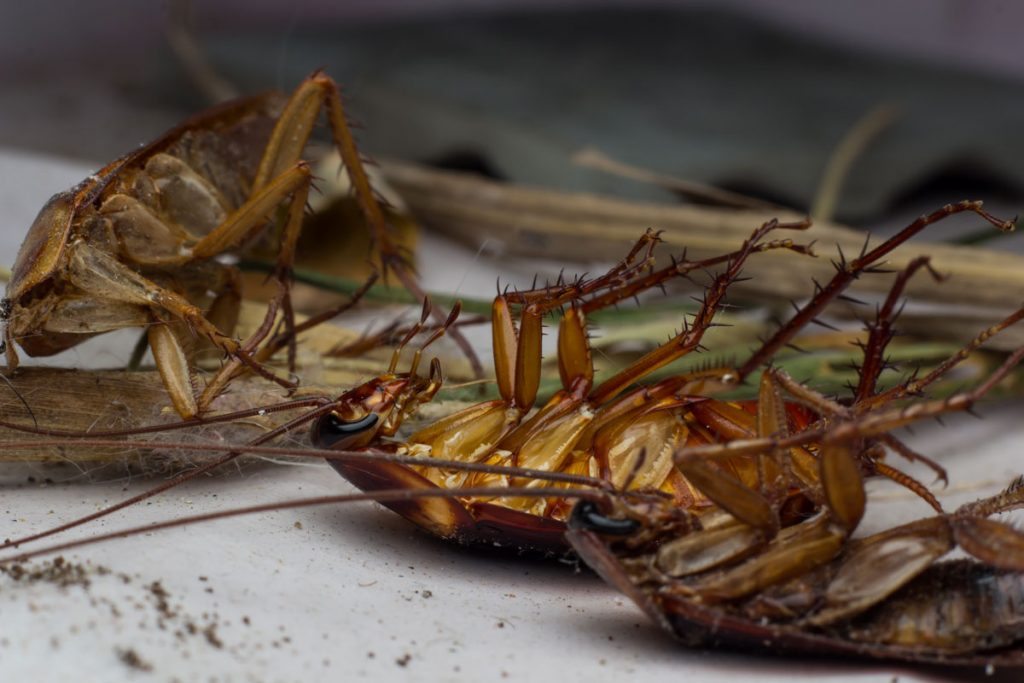No, they won’t really survive a nuclear holocaust – but cockroaches are so notoriously difficult to get rid of, we can see how that old joke took hold. Read on for everything you need to know about preventing, recognising and treating a cockroach infestation before it gets out of control – with serious consequences for your home or business.

Schedule an Inspection Today
Scientific classification
- Kingdom: Animalia
- Phylum: Arthropoda
- Class: Insecta
- Order: Blattodea
- Suborder: Various
- Infraorder: Various
- Superfamily: Various
- Family: Various
Cockroaches at a Glance
- Incredibly hardy and adaptable
- Can eat almost anything, including nothing at all: some varieties of cockroach can go up to three months without eating
- Can also tolerate a wide range of temperatures, which means it’s easy for them to make themselves at home in a wide range of habitats
- Around 4600 species are found throughout the world – 70 in the US
- Make distinctive hissing or chirping sounds
- Nocturnal: almost all species tend to scatter when exposed to light: in fact their scientific name, Blattodea, is derived from a Latin word meaning ‘insect that shuns the light’
- Will run away when approached, as they’re extremely sensitive to vibration and can detect the tiniest of movements
- Most cockroaches have a beneficial effect on their habitat, but four of the species found in the US are pests that can spread disease: the American cockroach (also known as the palmetto bug), Brownbanded cockroach, German cockroach and Oriental cockroach (sometimes referred to as water bugs). These varieties feed on human food (and/or pet food), may cause a bad smell, and can also cause an allergic reaction.
How Do Cockroaches Spread?
If you’re wondering how cockroaches got into your home, it may well be that you brought them there: roaches and/or their eggs may attach themselves to your clothes or belongings while you’re out of the house. If you move from a building with a roach infestation, it’s very common for the cockroaches to travel with you – be sure to thoroughly inspect, wash and vacuum your possessions as you pack. Try to use plastic bins to transport your stuff, rather than the cardboard boxes that cockroaches like to use as hiding places and food (all paper products are attractive to cockroaches). Discard plants and electronic appliances if possible – at the very least, pack them in sealed, clear plastic bags, keep an eye on them in your new home, and don’t unpack them until you’re sure they are not infested.

Health Concerns Related to Cockroaches
There are four main health concerns related to cockroaches:
Food poisoning. Cockroaches like to eat our food: they also like to eat many other things, including fecal matter, which they are likely to have trampled through before walking over the food in your kitchen. They may also defecate on your food themselves, as well as leaving behind their own egg shells. As if that wasn’t bad enough, they also carry salmonella.
Other diseases. Not only do they carry in germs on their feet, but cockroaches also regurgitate their saliva and digestive fluids onto food as they eat it; the bacteria in these fluids can cause digestive problems – see above – but also urinary tract diseases and even sepsis.
Allergies, including asthma. The saliva and body parts of cockroaches contain a number of allergens which can trigger reactions in humans. These could be typical allergic reactions such as sneezing, eye-watering and skin rashes, but could be life-threatening if you have asthma. Even if you’re not a pre-existing asthma sufferer, it may be possible to develop the condition by breathing in allergens from cockroaches.
Bites and invasions. Cockroach bites are rare, but in the case of a severe infestation they have been known to bite human nails, or toes and other soft parts of the skin. Also rare, but it’s not unknown for small cockroaches to enter the ear or nose cavities while humans are asleep.

What Are The Signs of Cockroaches in Your Home?
The most obvious sign that cockroaches are in the building is if you see one (or more than one). However, cockroaches are good at staying hidden: they’re nocturnal, great at detecting signs of danger, and tend to stay fairly near their nest so they can get back to it in a hurry. Because of this, you may well experience other signs of a cockroach problem before you actually spot a roach. Signs include:
- Feces. Large roaches leave brown or black cylindrical droppings, around 2mm long, but the feces of smaller insects look a little like coffee grounds, or black pepper. The more feces you find, the more cockroaches there are lurking nearby. If the cockroaches have access to water they may leave smear marks on horizontal surfaces instead.
- Smell. Many cockroach species emit an unpleasant odor that lingers on the materials that come into contact with it. This smell will be particularly strong if there is a large infestation, but just one cockroach can emit a noticeable odor.
- Shed skins or egg cases. Brown, oblong egg cases – known as oothecae – house many roach eggs and are left behind when the eggs hatch: you may spot them behind furniture, along with the discarded skins cockroaches will shed and leave behind as they mature.
Early Detection
Be alert to the signs of cockroaches in your home, as listed above: by the time you spot an actual cockroach, there may be a large infestation. Be vigilant around the warm, moist, dark places that attract roaches, particularly around food and water sources, but also anywhere that paper is stored. If you suspect a cockroach problem based on the signs listed above, put out store-bought roach traps around your home to check whether and where the cockroaches are, then proceed to the steps below.
I Have Cockroaches! How Do I Avoid an Infestation?
Once you suspect a cockroach problem and you’ve set out your roach traps, you need to start eliminating the cockroaches’ sources of food, water and hiding places.
Food: you need to clean your kitchen. Even if you think it’s already clean: cockroaches can squeeze through the tiniest cracks to get the tiniest morsels of food. A small spot of grease is a great food source for them. Think of this as a great incentive for your family to stay on top of kitchen chores:
- Make sure counters, shelves, and cupboard surfaces are wiped thoroughly and often
- Dirty dishes need to be quickly washed. Check for food waste at the bottom of the dishwasher.
- The kitchen should be swept and vacuumed daily – don’t forget to sweep behind your applicances.
- The garbage sealed tight and taken out regularly
- Your recyclables should all be thoroughly rinsed
- Keep all fresh food in airtight containers.
Water: check all faucets, drains, or anywhere else water collects. Deal with any drips, stopper your drains when not in use, and also ensure there is something in your faucets to prevent roaches crawling inside them. Other moist areas can include around pipes and plants, and beneath refrigerators: check these places every night before you go to bed and make sure they are dry.
Hiding places: tidy up any clutter where roaches could hide. In particular, throw out anything you can that is made of paper, such as cardboard boxes or piles of newspapers.
If you don’t see, hear or smell any further signs of cockroaches after taking these precautions, it may be that the roaches have moved on – but don’t relax just yet. Don’t forget, these insects can live for months on next to nothing, so remember to check your home regularly. If, on the other hand, your roach traps indicate that there is a large infestation, you should act swiftly to have the roaches exterminated.

DIY Pest Control
The most effective ‘at home’ way to keep cockroaches at bay is to keep your property clean, dry and clutter-free as above. It may be possible to treat small cockroach infestations by purchasing traps – as above – and/or bait kits, powders and sprays, and applying these yourself. You can even attempt completely DIY methods to kill cockroaches, such as lacing moist balls of fat with borax and placing them in affected areas of your home (if you’re going to try this, be sure to do it at night when the cockroaches are out and about but your kids are not; also be sure to place the poison out of reach of pets).
However, DIY treatments are unlikely to be effective over long periods of time – even if they kill every cockroach hiding in every corner of your home, they may not kill all the eggs. When these hatch, your problem starts all over again. To make sure anti-cockroach treatment is applied to every area of your home where these insects are nesting, hatching or hiding, call a pest control professional.
